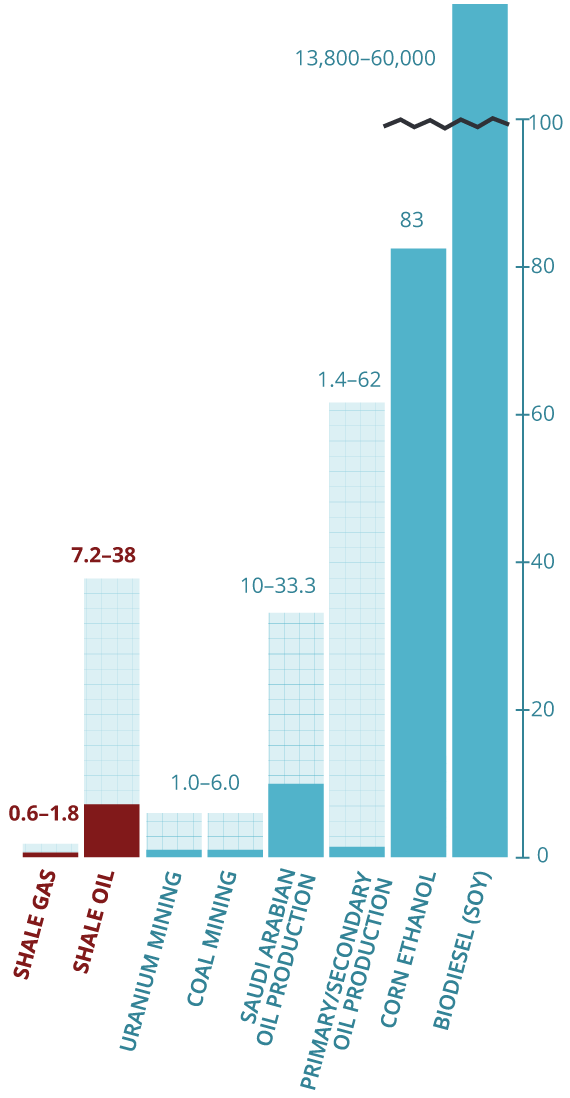PART ONE:
Getting the Fracts Straight
Hydraulic fracturing has its risk, but as we show in this video, scientific research suggests they are rare. Meanwhile, the process yields substantial economic gains.



Resource Extraction Water Usage Comparison

Gal./Water per Million British Thermal
Units of Fuel (gal/MMBtu)
for Various Energy Resource
Extraction Methods

Composition of Fracturing Fluid


Hydraulic Fracturing Adds Water to the Atmosphere

Burning methane (CH4) produces carbon dioxide and water. A hydraulic fracturing well uses approximately five million gallons of water with 80% underground, producing 1 billion cu. ft. of gas over 10 years. Burning the gas will replace the four million gallons of water left underground in 6 months, producing 11 million gallons over 10 years. The process adds water vapor to the atmosphere in the hydrological cycle.

PART TWO:
Top 5 Reasons Fracking Regulations are Whack
Government regulations on hydraulic fracturing are inefficient and ineffective. This video introduces property rights and water markets as an alternative way to monitor fracturing so as to reduce the risks and take advantage of the benefits.




What Are Property Rights?

They are the right or ability – as determined by law – for individuals, associations, or governments to control, benefit from, enforce ownership of, and transfer property.






In most cases, property rights protect the owner from taking another’s without due compensation. This is important in reducing the risks of fracturing because it protects owners of land and water from incursion of emissions associated with fracturing. In order for strong property rights to exist, there must be an incorruptible system in place to clearly define, consistently monitor, and strictly enforce the right.

Water Markets Prompt Innovation


The Word from
Wall Street Journal
-
 From energy industry giants Halliburton Corp. and Schlumberger Ltd. to smaller outfits such as Ecologix Environmental Systems LLC, companies are pursuing technologies to reuse the "frack water" that comes out of wells after hydraulic fracturing…
From energy industry giants Halliburton Corp. and Schlumberger Ltd. to smaller outfits such as Ecologix Environmental Systems LLC, companies are pursuing technologies to reuse the "frack water" that comes out of wells after hydraulic fracturing…
-
 Companies are researching moving away from using water entirely to fracture rock, with efforts aimed at using propane gel and even compressed air.
Companies are researching moving away from using water entirely to fracture rock, with efforts aimed at using propane gel and even compressed air.
-
 [Jeanie Oudin, an analyst with energy consulting firm Wood Mackenzie] said operators have reported recycling—which eliminates the cost of disposal and the cost of acquiring fresh water for fracking—can cut costs by as much as $2 per barrel in some areas when done on site, which could equate to a $200,000 savings over the lifetime of a typical well.
[Jeanie Oudin, an analyst with energy consulting firm Wood Mackenzie] said operators have reported recycling—which eliminates the cost of disposal and the cost of acquiring fresh water for fracking—can cut costs by as much as $2 per barrel in some areas when done on site, which could equate to a $200,000 savings over the lifetime of a typical well.
-
 The interest in water recycling is creating opportunities for small companies such as Select Energy Services LLC, a closely held Houston firm that said it has had a rapid rise in demand for its water-recycling services. It currently has full-scale operations in four areas including North Dakota and Colorado, up from one at the end of last year, as more companies examine recycling frack water.
The interest in water recycling is creating opportunities for small companies such as Select Energy Services LLC, a closely held Houston firm that said it has had a rapid rise in demand for its water-recycling services. It currently has full-scale operations in four areas including North Dakota and Colorado, up from one at the end of last year, as more companies examine recycling frack water.


— Alison Sider, Russell Gold, and Ben Lefebvre,
Drillers Begin Reusing "Frack Water,"
Wall Street Journal, Nov. 2012
PART THREE:
Swipe Right: Seeking
Fracturing Policy Alternatives
Requiring hydraulic fracturing operators to tag their fracturing fluids with tracers helps enforce the property rights of others who may be harmed. This, in turn, enables more use of insurance, surety bonding, self-regulation, and third-party verification/certification to reduce and protect against the real but rare risks of fracturing. As this video presents, property rights hold producers accountable and take advantage of fracturing benefits.



What Are Tracers?

Non-harmful, unique additives that can individually finger-print water to determine its point of origin. Such tracers are used extensively by the Lawrence Livermore National Laboratory for water-related research. New scientific advances are developing more robust, long-lasting tracers that would enable wide-spread commercial use.

“Barron and other researchers hope this tracer will settle once and for all whether oil and gas companies are damaging drinking water, and, in the event of contamination, allow communities to determine who – or what – is at fault.”


“Each tracer is a unique sequence, and each well will be assigned its own tracer, which allows a precise accounting of where the contamination came from. If a tracer assigned to well A shows up in an aquifer, that’s evidence that that well or a fracture in the rock linked to it is connected to that aquifer.”


“In line with improving public trust, the new technology could help regulators sidestep trying to require companies to give away the specific ingredients in their fracking fluid, which the industry often regards as proprietary information.”
— Tay Wiles, “New tech to trace fracking fluid could mean more accountability,” High Country News, August 2013












